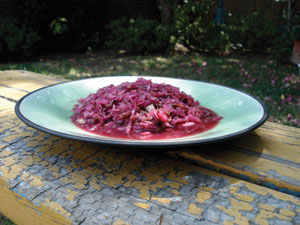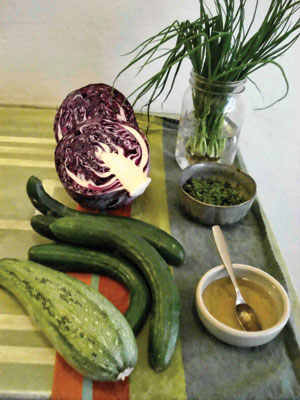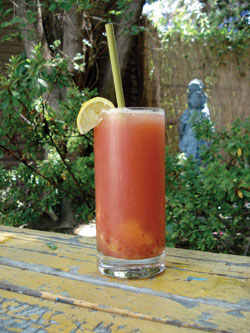Body Ecology author Donna Gates is a believer. “Fermented foods were one of the most important aspects of my own path to understanding health at a deeper level and are absolutely essential for creating a foundation for wellness.” Fermented foods are living cultures that are part of the traditional diets of people around the world, and many treat the starter microorganisms as treasures passed down from one generation to the next. These include foods such as kefir, miso and kim chee. Gates says, “We can’t physically see microflora, so it’s hard to grasp how they’re important; but we really don’t know what true health is without that ecosystem is in place.” For health conditions from digestive disorders to autism, people are finding that fermented foods are helping them rediscover wellness. Gates does caution newcomers, “When you first start to take in fermented foods, they will start to change the environment of your intestines, and you might have signs at first like gas or bloating.” She instructs people to stick to it while simultaneously incorporating cleansing programs (with a qualified guide) to support intestinal health and start on the path to having the best digestion and immune system ever.
Find out more about Donna Gates and Body Ecology at: bodyecology.com. For more information about fermented foods, prebiotics and probiotics, look for the September, 2009, issue of LA YOGA Ayurveda and Health.
Farmers’ Market Kefir Salad
By Chris Lyans
Coconut kefir provides a light culture to ferment farmers’ market vegetables. Be creative with this recipe and peruse the fresh fare,
be original, go with what is in season and looks good to you. Fresh vegetables are rich sources of numerous vitamins, minerals and phytochemicals. Add herbs and spices for your tastes and needs and try harvesting them from your windowsills, yard or patio [see the story on container gardening in the June, 2009, issue of LA YOGA.]
Cilantro, used in this recipe, is a fast-growing herb that is a potent source of multiple nutrients, including: B vitamins (including folic acid), Vitamins A and C, lutein, potassium, iron, zinc, copper and other health-promoting phytochemicals such as polyacetylenes, flavonoids, coumarins and monoterpenes. Cilantro is also used to help detoxify heavy metals from the body, particularly after amalgam has been removed.
Preparation: Cut the vegetables as finely as possible and then mix them together in a large bowl with honey or sugar and kefir. The amount of sugar naturally present in the vegetables you choose will determine how much sugar you should add. For sweeter vegetables, add less. At the end, the sugar will be utilized fully for the fermentation process.
After mixing, put the vegetables in a large glass jar and mash them with a pestle until the liquid separates from the veggie pulp. Then tamp down the veggies until the liquid covers them. Let this ferment in the jar for one to three days. While doing so, keep checking on the vegetables and press them down as they rise so they stay completely covered by the liquid. Once they have fully taken on the culture, refrigerate them and enjoy. If you are not accustomed to the slightly sour taste of fermented vegetables, expect a something different than a just-chopped garden salad, but know they just right if the colors are still vibrant. We are more habituated to sweet taste than sour, but the sour taste is an important digestive stimulant, which is part of what makes this recipe beneficial.
In this recipe:
One half head of purple cabbage
One bunch of cilantro
Two small bunches of mini green onion
One tablespoon of honey or raw sugar
Two-three ounces of coconut water kefir
Summer Citrus Coconut Splash
By Garry Cooperman
This refreshing and colorful mocktail is full of Vitamin C, more hydrating (by far) than a cocktail, and rich in minerals such as potassium and copper.
Young coconut water kefir
Juice of (or freshly squeezed):
Orange Blood
Orange Tangerine
Fresh Lime
Preparation: Blend four ounces coconut water kefir, four ounces orange juice, two ounces tangerine, one ounce of blood orange and a splash of lime with crushed ice to chill a hot summer day.
Chris Lyans and Garry Cooperman have had plenty of time to experiment with all of the different possibilities for crafting recipes using coconut kefir since they are two of the three masterminds (including herbalist and healer Desiree Romero) of Tonix Coconut Kefir, located in Los Angeles. Find out more about Tonix Botanical Solutions at: mytonix.com.
Chillin’ On Dessert
You may wonder what to do when craving a cold, sweet dessert, particularly something suitable to share with the family in the heat of the summer and are weighing the options. From the perspective of Ayurveda, milk-based ice creams are cold, heavy and kaphagenic (increasing the dense earth and water elements). And if you’re a vegan, you just don’t believe those are happy cows. You may be suspicious of soy because of GMOs, phytoestrogens and conflicting information about thyroid-inhibiting compounds. There’s goat’s milk, which is more heating and digestible than cow’s milk, but not vegan (LaLoo’s: goatmilkicecream.com) as well as Rice Dream, an old-school vegan delight. One of the newest frozen treats to take the vegan dessert-loving world by storm is Coconut Bliss. I was first introduced to it by scooper and blisslover Kris Willey. My current favorite flavor? The chocolate hazelnut. Smooth, creamy, coconut, chocolate, what’s not to love? They scooped for us at the YogaGlo/LA YOGA Summer Kick-Off party, and they’ll be sharing the bliss at Bhakti Fest in September, fueling the bhav with flavors like guilt-free mint galactic, cappuccino, strawberry lemon love and cherry amaretto (yum). Agave syrup, fair trade and organic ingredients fill out the love. coconutbliss.com.
–– FMT
By Felicia M. Tomasko, RN
Felicia Tomasko has spent more of her life practicing Yoga and Ayurveda than not. She first became introduced to the teachings through the writings of the Transcendentalists, through meditation, and using asana to cross-train for her practice of cross-country running. Between beginning her commitment to Yoga and Ayurveda and today, she earned degrees in environmental biology and anthropology and nursing, and certifications in the practice and teaching of yoga, yoga therapy, and Ayurveda while working in fields including cognitive neuroscience and plant biochemistry. Her commitment to writing is at least as long as her commitment to yoga. Working on everything related to the written word from newspapers to magazines to websites to books, Felicia has been writing and editing professionally since college. In order to feel like a teenager again, Felicia has pulled out her running shoes for regular interval sessions throughout Southern California. Since the very first issue of LA YOGA, Felicia has been part of the team and the growth and development of the Bliss Network.




